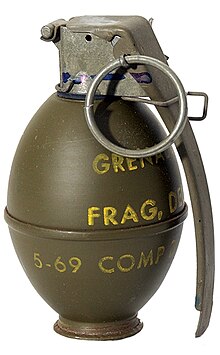| M26 grenade | |
|---|---|
 M61, a variant of the M26 (manufactured in May 1969) | |
| Type | Hand grenade |
| Place of origin | United States |
| Service history | |
| In service | 1950s–present |
| Used by |
|
| Wars | Korean War Vietnam War Six-Day War Yom Kippur War Falklands War Syrian Civil War |
| Production history | |
| Produced | 1950s–present |
| Specifications | |
| Mass | 16 oz. [454 g][1][2] |
| Length | 99 mm[1] [3 7/8 inches] |
| Diameter | 57 mm[1] [2 1/4 inches] |
| Filling | Composition B |
| Filling weight | 5.75 oz. [164 g][1] |
Detonation mechanism | M204-series Timed Friction Fuse [3] |
The M26 is a fragmentation hand grenade developed by the United States military. It entered service in 1952 and was first used in combat during the Korean War, replacing the Mk 2 of World War II. The M26 series was the primary fragmentation grenade used by American forces in the Vietnam War. It was replaced by the M33 series grenade. Its distinct lemon shape led it to being nicknamed the "lemon grenade" (compare the Russian F1 and American Mk 2 "pineapple" grenades).
- ^ a b c d LEXPEV. "M26, M26A1 & M61". Lexpev.nl. Retrieved 2014-05-03.
- ^ "Hand Grenades". Inetres.com. Retrieved 2014-05-03.
- ^ "Table 1: Authorized Hand Grenades". Archived from the original on 2016-03-04. Retrieved 2013-03-19. Training Manual TM-9-1330-200-12 Grenades. Table 1: Authorized Hand Grenades3